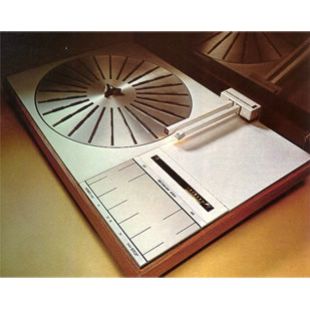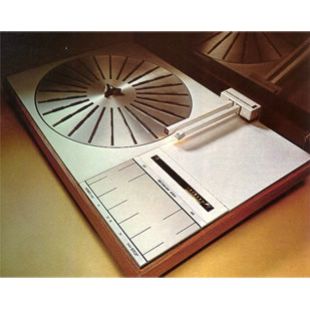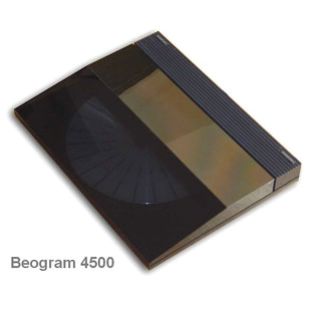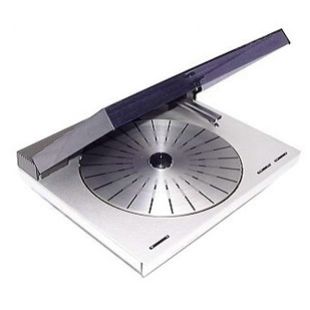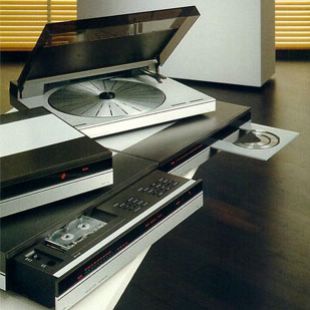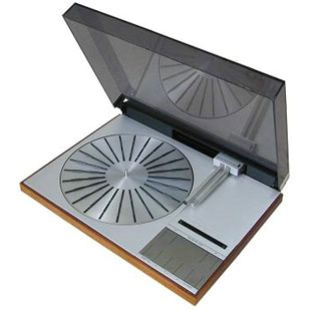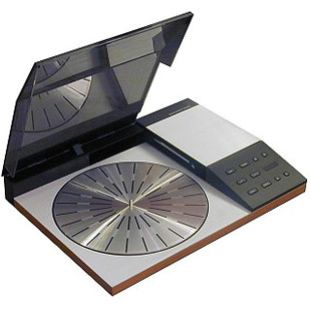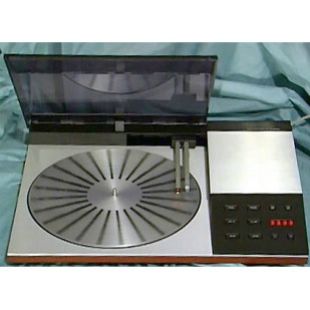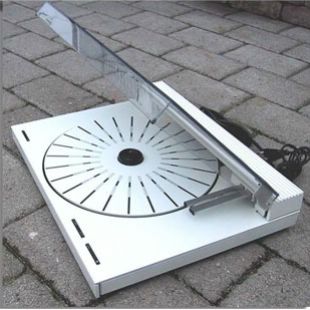BeoGram 4000
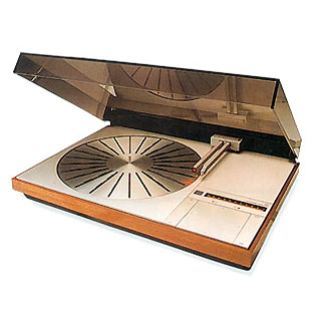
BeoGram 4000
In this pioneering concept, the pick-up moved in a straight line towards the centre of the record parallel with – or tangentially in relation to – the groove. By doing so, the small angular error which would otherwise occur when the pick-up arm moved in an arch on a conventional gramophone was removed. This was possible because the pick-up arm was electronically controlled by a light spot reflected off the record.
This method also ensured that the gramophone started automatically, selected the desired speed – and that the pick-up actually touched the grooves of the record. The combined cartridge/stylus used on Beogram 4000 was the ultra-lightweight SP15 which was engineered by Subir Pramanik especially for this deck.
Yet another sophisticated mechanical design, the double tone arm, demonstrated the break with the past. By using two arms, it was immediately clear that this was a gramophone which worked in a new and different way.
Beogram 4000 was the first of the many tangentially-tracking record players that followed, finished in wood veneer, aluminium and plastic. Designed by Jacob Jensen, Beogram 4000 and seven other B&O products were selected by the Museum of Modern Art in 1972 for its permanent collection of modern design. Jensen aimed at creating a record player which in its simplicity and panache was both timeless and up-to-date in its technical construction. The record player made use of the most advanced techniques; for instance, the electronic tangential pick-up arm, which by moving in a straight angle from the end of the record player always played the record at the correct angle – that which it was created with in the factory. The delicateness of the pick-up arm was also a part of making the design simple and attractive to look at. The same year, Beogram 4000 won the ID Award.
The design and development process of the Bang & Olufsen Beogram 4000 turntable was carried out somewhat different to the normal procedure. Jacob and K G Zeuthen, a civil engineer – who had been one of Denmark’s pioneers in aviation design – developed and constructed a full size working model ready for presentation to B&O. The design incorporated a parallel twin-armed pick-up, one arm for the pick-up and the other arm with an optical device which read the size of the record. Beogram 4000 was put into production without alteration and became a tremendous success. It gained many international design awards and contributed in maintaining B&O’s sharp design profile. In 1972 Beogram 4000 won the iF Design Award and in 1973 it received the Danish ID Award; that same year it was included in the New York’s Museum of Modern Art (MoMA) Design collection. It also received the English Blue Ribbon award that year for outstanding design who labelled the deck as “the most awarded product within the Radio trade”
With his design work, Jacob Jensen helped shape Bang & Olufsen’s product design with its characteristic use of discrete, clear lines and high functionality. It is a design which has helped manifest B&O’s easily-recognisable product identity. Through the assistance of Jacob Jensen, B&O was awarded the Danish Design Centre’s ID Classic Prize in 1990 for its product design through 25 years.
While the CD player has now replaced the gramophone, Beogram 4000 was regularly updated for many years, bearing different names and Type numbers – for the continued pleasure of music lovers who refused to give up their beloved LP collection.
BeoGram 4000 Product Specifications
Type: 5215 (1972 – Dec 1974)
Designer: Jacob Jensen
Manufactured: 1972 – 1974
Colours: Rosewood, Teak, White
Speeds: 33 – 45 rpm. electronic section
Pickup-arm System Tangential
Automatic Record-size Scanning Yes
Automatic Pickup movement Control Yes
Automatic Speed Selection Yes
Cueing Control Electronic air pressure damped
Drive system: Belt
Motor Synchronous electronically controlled
Stroboscopic Scale Light indicator 33 and 45 rpm: 50 and 60 Hz
Wow and flutter: < +/- 0.05 %
Rumble A: > 46 dB, B: > 65 dB
Speed Control Range: > 6 %
Pick-up: SP 15
Stylus ‘Pramanik’ elliptical naked diamond: 5 x 17µ
Recommended, Stylus Pressure: 1 g
Stylus Pressure Range: 0 – 1.5 g
Power supply: 110 – 130 – 220 – 240 V / 50 – 60 Hz / 40 W
Dimensions H x W x D 10 x 49 x 38cm
Weight 12 kg
Upgrade your membership to view documents
BeoLab 2000
BeoLab 2000 With BeoLab 2000 the customer is able to extend choices with a range…
BeoVox S40
BeoVox S40 Beovox S30 and S40 both used a two-unit configuration and pressure chamber design to reproduce…
BeoLab 17
BeoLab 17 BeoLab 17 is a solid, impressive loudspeaker withpowerful sound that punches way beyond…






